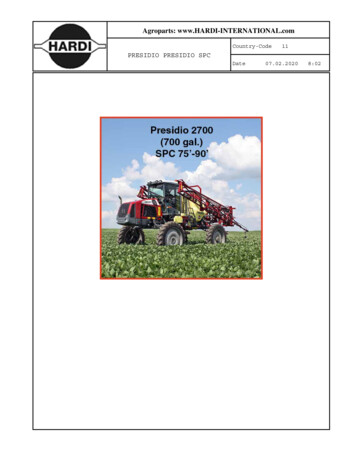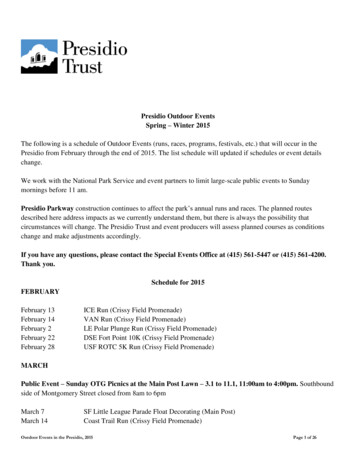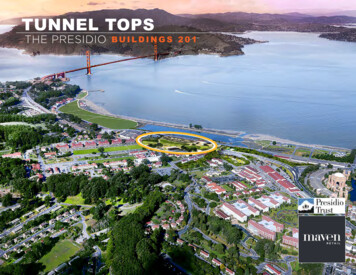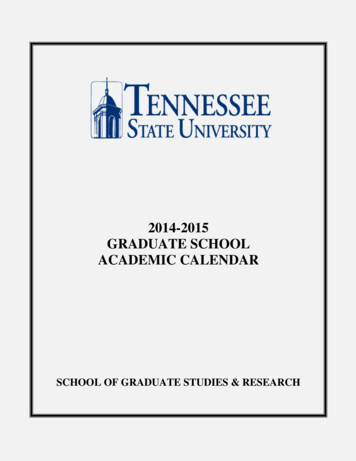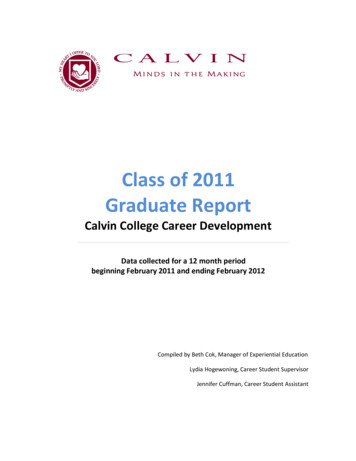
Transcription
4San FranciscoPrepared forSan Francisco Planning DepartmentMay 2014IAPresidio Graduate SchoolJonathan DirrenbergerCheryl DorseyRyan MillerSonia O’Claire
Contents1Executive Summary32Background432.1San Francisco Urban Forest Plan42.2Study Scope and Methodology42.3San Francisco Sustainability Initiatives52.4Current San Francisco Wood Re-Use Efforts52.5Urban Wood Re-Use Case Studies68Uses of Urban Tree Wood83.1Viable Options3.2Process Diagram123.3Comparison and Elimination of Options124Stakeholders195Valuation and Cost Analysis215.1Considered Options215.2Demand Forecast215.3Potential Financial Value of Wood Products225.4Cost Analysis23626RecommendationsKey Recommendation 1: DPW & RPD Maximize the Value of Urban Wood by Harvesting Lumber and Logs from RemovedStreet and Park Trees266.2Key Recommendation 2: DPW Process and Store Wood Chips, Mulch, and Compost276.3Key Recommendation 3: Explore the possibility of DPW and RPD Sharing Wood Processing Facilities and Equipment286.4Secondary Recommendations296.17Barriers to Implementation318References329 Appendices349.1AppendixA: Cincinnati Urban Wood Re-Use Flowchart349.2Appendix B: Street Tree Census Data35Photo credit, cover: partners.sfoarksalliance. orgPhoto credit, page 3: bkusler at flickr.comPresidio Graduate School2SF Urban Forest Wood Re-Use StudySan Francisco.Disclaimer: this document was prepared by students from Presidio Graduate School and as such the contents do not necessarily reflect the views and policies of the City of
ji2. RPD operates a successful park tree wood processingfacility in Golden Gate Park where it chips all treesremoved from its property and uses the wood chipsdirectly or turns them into mulch or compost for usewithin City parks. RPD also uses logs from treesthroughout the parks as barriers, benches, etc. RPDrarely needs to buy wood chips, mulch, or compost fromthird-party landscape suppliers.3. Neither DPW nor RPD are creating lumber or specialtywood products from removed trees.4. Street trees experience harsh conditions and their sizeand wood quality is usually low such that only anestimated 10-15% is suitable for lumber. Park trees arelarger and usually of better quality such that anestimated 15-20% is suitable for lumber.5. The estimated potential value of DPW and RPD removedtrees is estimated to be between 22,000 and 62,000.6. Other cities have successfully implemented urban woodre-use programs that prioritize lumber and serve asexamples for the City of San Francisco.7. A wood re-use program has the potential to capture asignificant amount of the carbon stored in urban treesthat would otherwise be released into the atmosphere(as is the case for mulching and composting). Moreimportantly, wood products can displace products thatare much more carbon intensive.J1 Executive SummaryA comprehensive study was undertaken to understand theexisting state of urban forest wood usage in the City of SanFrancisco and make recommendations on how to better alignthis process with the following broad sustainability strategiesset forth by the City of San Francisco: Better management of urban trees throughout theirentire life cycle and increased awareness amongst SanFrancisco residents and local woodworking craftsmanand artists as to the value of urban trees at end-of-life(EOL) per the Urban Forest Plan (2014) Reduction of greenhouse gas (GHG) emissions per theClimate Action Plan (San Francisco Department of theEnvironment, 2004) Reduction of materials sent to landfills per the ZeroWaste policy (City of San Francisco, 2002)These findings reveal that, though the vast majority of urbanwood in San Francisco is successfully diverted from landfills,opportunities exist to better meet the City’s variessustainability goals and maximize higher value uses of the City’surban tree wood waste.The scope of the study is urban trees that have been removeddue to safety concerns, death, disease, vandalism, impact froma vehicle or other manmade object, severe weather, orenactment of a tree removal permit. Street trees that areremoved by the San Francisco Department of Public Works(DPW) and currently make up approximately 16% of SanFrancisco’s urban forest are the primary focus of the study.However, trees maintained by the San Francisco Recreationand Parks Department (RPD) and which make up approximately20% of the urban forest are also considered. The proposedrecommendations are still applicable if the scope is expandedin the future to include trees on private property removed byprivate contractors.Therefore, the following key recommendations are proposed:1. DPW and RPD should harvest lumber from removedtrees to build support, increase visibility, and display thepotential of a wood re-use program. This process shouldbegin with a pilot sawmilling program to create roughsawn lumber for City use. The City should create aconsortium of local wood-working craftsman and artistswho will use lumber from removed City trees to createhigh-visibility wood products to build support, increasevisibility, and display the potential for a larger scalewood re-use program.2. DPW should develop the capability to process and storewood chips, mulch, and compost created from removedstreet trees.3. Removed urban trees should be assigned an EOL fateaccording to the following priority, from highest tolowest: lumber, logs, wood chips/mulch/compost, andhog fuel (via Recology).4. The City should explore the possibility of sharing woodprocessing facilities and equipment for street trees(DPW) and park trees (RPD) to maximize efficiencies,minimize costs, and create a consistent and cohesivewood re-use program.The major findings of this study are:1. DPW currently chips most Street trees on-site and sendsthem to Recology where they are shipped to compostfacilities. Street trees too large to be chipped are hauledas logs to Recology who sends them to biomass powerplants where they are incinerated to create electricityfor PG&E. DPW purchases wood chips, compost, andmulch from third-party landscape suppliers.Presidio Graduate School3SF Urban Forest Wood Re-Use StudyDisclaimer this document was prepared by students from Presidio Graduate School and as such the contents do not necessarily reflect the views and policies of the Cily of San francisco,
Recreation and Parks Department (RPD, 131,000 trees or 20%of the urban forest). DPW is responsible for maintaining andhence removing all street trees while RPD is responsible formaintaining and hence removing all trees in City parks.2 BackgroundThis study is the result of a semester-long Experiential Learningproject by students in the Spring 2014 Operations andProduction course at Presidio Graduate School’s SustainableManagement MBA program, working with the City of SanFrancisco Planning Department.In late 2013, AECOM produced a financial study for the SanFrancisco Planning Department and DPW (AECOM, 2013) whichevaluated the costs and benefits of a comprehensivemunicipally-operated street tree program in San Francisco andassessed potential financing strategies to generate revenue forsuch a program. AECOM’s study focused on the financial cost ofa tree through its entire life cycle but did not focus on how thetree was handled after it was felled and removed from theurban forest.2.1 San Francisco Urban Forest PlanThe San Francisco Planning Department and Department ofPublic Works (DPW) recently released their Urban Forest Plan(City of San Francisco, 2014), with the first phase focusing onstreet trees. This plan provides the following keyrecommendations: Maximize the benefits of urban trees Grow the street tree population by 50% (50,000 newstreet trees) Establish and fund a citywide street tree maintenanceprogram Manage trees throughout their entire life-cycle22 Study Scope and MethodologyThis study focuses on assessing current wood processingoperations for street trees (maintained by DPW) and park trees(maintained by RPD) in the City of San Francisco. However, theresults herein could be relatively straightforwardly expanded toinclude trees delivered from private property owners to a Cityowned and maintained wood processing facility. This studypresents recommendations for meeting the Urban Forest Plan’sgoal of maintaining trees throughout their life cycle,particularly the end of their life cycle. The scope of this studywas to:1. Ascertain the current process that DPW and RPD use forhandling removed urban trees2. Evaluate different methods of re-use for removed urbantrees3. Make recommendations on how to treat removed urbantress and strategies to implement these practicesThe final recommendation is most relevant to this study ofurban wood re-use as it specifically calls attention to the endof-life (EOL) stage of the urban tree. The life cycle stages of anurban street tree are shown in Figure 1 with phases relevant tothe wood re-use plan are shown in green./0COMPOST0SEED0 SfEDI INC. ;ApLIrC.,WOOD PROtMJCT5During their research, the authors conducted interviews withthe following City staff: Jon Swae, Planning Department Anne Brask, Planning Department Carla Short, Urban Forester/Deputy Bureau Manager,DPW Denny Kern, Director of Operations, RPD Kelly Cornell, Tree Topper Supervisor, RPD01) iI3AN WCC)P0 STIll FTTIiEEIn addition, the authors conducted interviews and/or hadpersonal communication with the following: Doug Wildman, Program Director, Friends of the UrbanForest (FUF)Scheid, Forestry Assistant II, CaliforniaJames Department of Forest and Fire Protection (Cal Fire),Urban Forestry Program Ralph Mize, City Arborist, City of San Jose, CA Tony Wolcott, Maintenance Supervisor Urban Forester,City of Albany, CA Daniel Gallagher, Senior Forestry Supervisor, City ofBerkeley, CAFigure 1: Street tree life cycle stages with those most relevantto this study shown in green. (Credit: modified from the SanFrancisco Urban Forest Plan)The majority of urban trees in San Francisco not on privateproperty, federal land (e.g. Golden Gate National RecreationArea), or state land (e.g. San Francisco State University andUniversity of California San Francisco) are maintained by eitherDPW (105,000 trees or 16% of the urban forest) or thePresidio Graduate School4SF Urban Forest Wood Re-Use StudyDisclaimer: this document wa.s prepared by students from Presidio Graduate School and as such the contents do riot necessarily reflect the views and policies of the City of San Francisco.
comprehensivestreetmunicipally-operatedtreeprogram with Department of Public Works(San Francisco Recreation and Parks Department, 2013)Marcus Goodman, Senior Program Specialist, City ofOlympia, WABernie Lenhoff, Operations and Marketing Manager,Green Waste Recycle Yard, the recycling division of TheProfessional Tree Care CompanyBlair Glenn, Arborist and Owner of Saratoga TreeService, CAMichael Coonen, Joinery Structures, Oakland, CARepresentatives from Recology2.4 Current San Francisco Wood Re-UseEffortsSince 1932, the City of San Francisco has been in partnershipwith Recology, a San Francisco-based resource recoverycompany. The City has partnered with Recology in an effort tolead the nation in diverting material from landfills andmaximizing the use of recycled materials including urban treewood. This program has been highly successful and in 2012reached a landfill diversion rate of 80%, the highest in thenation (Mayor Lee Announces, 2012).Fields research was conducted at: RPD’s wood processing facility in Golden Gate Park inSan Francisco Joinery Structures in Oakland2.3 San Francisco Sustainability InitiativesCurrently, when a street tree is removed by DPW, the woodydebris (trunk and branches) is either chipped on-site if 12” orless in diameter or bucked (logs are cut into manageablesections) on-site. The 12” limitation on the diameter is due tothe capacity of DPW portable wood chippers (an example ofthe largest wood chipper model used by DPW is shown inFigure 14). Both wood chips and logs are then hauled by DPWto Recology. Recology chips logs with diameter 12” to 24”. Allwood chipsthose hauled to Recology by DPW and thosecreated by Recology join the general compost stream thatRecology collects from San Francisco residents and businessesand is sent to industrial composting facilities in NorthernCalifornia where the resulting compost is sold to farmers,vintners, and local residents (Howard, 2013). Logs withdiameter greater than 24” join Recology’s stream of non-treewood debris (used 2x4s, pallets, plywood, etc.) unsuitable forcomposting or mulching due to contamination with toxicchemicals (paints, pesticides, waterproofing agents, etc.).These are sent to biomass power plants in the Central Valleyand incinerated to generate electricity for California’s largestutility, Pacific Gas and Electric (PG&E). DPW currently buyswood chips, soil, and mulch as needed from landscapesuppliers. Tn 2013, DPW bought 600 yards of wood chips and 25yards of soil from a landscape supplier (Short, 2014).The City and County of San Francisco requires City departmentsto track and report their greenhouse gas emissions in annualdepartmental Climate Action Plans. These plans track vehiclefuel, building energy usage, water usage, employee practicesrelated to waste, and purchasing. This process was establishedto help departments identify how to improve operations,reduce their carbon footprint, and address climate change.Some of the City’s sustainability goals related to this urbanwood re-use study are described below.——Department of the Environment Increase composting to divert solid waste from landfills Reduce greenhouse gas (GHG) emissions as follows:o 25% below 1990 levels by 2017o 40% below 1990 levels by 2025o 80% below 1990 levels by 2050(San Francisco Planning Department, 2010)DPW Reduce C02 emissions from transportation by 963,000tons annually Support transformation of pavement to parks throughthe Pavement to Parks program Facilitate increased sidewalk landscaping as a means toincrease permeable square footage in the public right-ofway(San Francisco Department of Public Works, 2013)RPD currently chips or grinds all trees removed from itsproperty at its wood processing facility in Golden Gate Park andeither uses the wood chips directly or turns them into compostor mulch for use within the parks (Kern & Cornell, 2014). Anaerial view of this facility and its location within the City isshown in Figure 2 and Figure 3, respectively. RPD rarely needsto buy wood chips, compost, or mulch from landscape supplierssince its wood processing facility supplies almost all of its needs(Kern & Cornell, 2014).Planning Department Planning Code Section 138.1 generally requires theplanting of one street tree for every 20 feet of streetfrontage on projects that meet the Section 138.1threshold requirements (San Francisco PlanningDepartment, 2013)RPD Although this arrangement successfully diverts most EOL urbantrees from landfills, it is not without limitations. The currentsystem for hauling wood waste to Recology and then in turn toEOL wood processors is responsible for GHG emissions andimposes a financial cost on the City. In addition, Recology sellsMaintain 96% green waste diversion rateInvestigate the financing opportunities provided byincorporation of Recreation and Parks into aPresidio Graduate SchoolSF Urban Forest Wood Re-Use Study5Disclaimer: this document was prepared by studcnts from Presidio Graduate School and as such thecontentsdo not necessarily reflect the views and policies of the City of San francisco.
Sacramento’s urban forest consists of approximately 115,000trees, similar to the amount managed by DPW in San Francisco.An image of their tree canopy coverage is shown in Figure 4.They have an urban canopy goal supported by the citygovernment and strong volunteer support. It should be alsonoted that even with a successful program, the city continuesto identify room for improvement and is in the process ofoverhauling their now outdated program in favor of a morerobust and updated urban forest plan. This plan is set to becompleted by the end of 2014 with the goals of: consolidatingcity ordinances regarding urban trees into a single, clear andconcise ordinance and aligning new policies with newdevelopments, capital improvement projects, streetscapes,park maintenance, and water and energy conservationprograms. An example of the winning design for the “CapitalCanopy” in Sacramento is shown in Figure 5.DPW’s and RPD’s wood waste to EOL wood processors whoprofit from EOL urban trees that could otherwise benefit theCity of San Francisco. Finally, no lumber is being created.Figure 2: Aerial view of ‘s wood processing facility in GoldenGate Park. (Credit: Gao gle Maps)F1aci,,IUS5S.J,I,,uthiy‘anciscoj,W1k sfHighlighted successful implementation strategies include: Regularly scheduled tree maintenance programs City wide standards for tree reuse Sharing between city departmentsPac,i,nReference: (City of Sacramento)4t.s.!.’mo,i.3t I,AW’,t,ifliAt at a51Sun’IflttFortIan �ayiewfP( Hwdr’cj‘uk4,‘7Figure 4: A view of Sacramento’s urban forest. (Credit:Figure 3: Location of RPD’s wood processing facility in SanFrancisco’s Golden Gate Park (red circle). (Credit: Google Maps)localwiki.nejj2.5 Urban Wood Re-Use Case StudiesWood re-use programs in other cities were investigated in thecourse of this study. A few notable examples and highlightsfrom their efforts are shown below.Sacramento, CASacramento is recognized by the American Forests Organizationas one of the top 10 best cities for urban forest in the UnitedStates (10 Best Cities for Urban Forests). Sacramento’s currentUrban Forest Management Plan (Wolfe Mason Associates,1994) has been in place since 1994 and has been widelyregarded as a success. Many of the practices implemented inSacramento during the mid-1990s are recommendations thatSan Francisco is currently trying to embrace with its own UrbanForest Plan.Presidio Graduate SchoolFigure 5: The winning design for Sacramento’s “CapitolCanopy”, the urban forest near the California state capitol.(Credit: atlaslab.netj6SF Urban Forest Wood Re-Use StudyCity of San Francisco.Discltcrncr. this document was prepared by students 1mm Presidio Graduate School and as such the contenrs do not necessarily reflect the views and policies of the
Olympia, WACincinnati, OHOlympia, a city known for abundant foliage and trees, isevaluating the use of urban wood for lumber through a WoodWaste Utilization Report (Roush & Royer, 2002). Ofapproximately 50 trees that are taken down a year, half areused for urban lumber or processed wood. The goals of theprogram include achieving artistic, environmental, andeconomic gains. Recommended methods of marketing urbanlumber include: offering a Wood Artisans Grant program, publicauctions, use in high school wood shop programs, and retailsales to support their urban forestry programs. In order tostore their inventory, they have suggested partnering withadditional city departments, specifically the Port of Olympiawhich can rent excess capacity. They have also created anaccessible reference list of instructions for regulatoryrequirements and private contractors to assist in theimplementation and operations of the program.Cincinnati’s urban street tree program began in 1981 andmaintains over 80,000 trees. Urban tree utilization operationsstarted in the late 1990s but the discovery of invasive pests andtree removals in 2006 spurred a more thorough programintroduction. Cincinnati was successful in implementing an EOLprogram for ash trees by using creative and coordinated effortsbetween multiple stakeholders. By facilitating a broad alliancebetween the city’s urban forestry unit, schools and techprograms, private tree owners, private mills, and tree servicescompanies, they have been able to create a useful wood re-useprogram and wood products for use within their community.Highlighted findings and implementation strategies include: Creative entrepreneurs necessary for implementation Shared resources and coordination necessary (city notcapable of adequately operating its own program) Desire to meet LEED certification standards for schoolswas an initial driving force for implementation Desire to minimize invasive pests another force ingaining support from mayor EOL tree wood products include:o Cubbies, bookcases, building materials, and pencilsfor elementary schoolso Materials for furniture-making at technology highschoolso Materials for props for local performing artsschoolsReference: (Roush & Royer, 2002)Figure 32 in Appendix A illustrates the process flow chart for asuccessful and exemplary wood re-use program undertaken bythe City of Cincinnati. Removed park and street trees (andsome trees from private property) are sent to the CincinnatiParks Department depot where some are sawed directly by thecity and some sent to a private sawyer for sawmilling. Thesawed logs are then sent to a private furniture woodworkerwho purchases the finished lumber and builds cubbies andbookcases. The finished cubbies and bookcases are then sold tothe Cincinnati Public schools. The school budget pays theprivate sawyer and the private furniture company each for thevarious stages of wood product.Figure 6: A view of the Washington state capital building inOlympia. (Credit: evergreen.edu)Reference: (WERC, United States Forest Service, 2012);.‘‘jFigure 7: A sketch of the urban forest around Olympia’s HandsOn Children’s Museum. (Credit: visitolympia.com)Presidio Graduate School7SF Urban Forest Wood Re-Usc StudyDisclaimer: this document was prepared by students from Presidio Graduate School and as such the contents do not necessarily reSect the views and poIice of the City olSan rrancisco.
Along with lumber, Jogs not designated as firewood representthe highest and best usage of tree wood; the reasons for thiswill be discussed in more detail later.3 Uses of Urban Tree WoodAscertaining the effectiveness of an urban wood re-useprogram requires a basic understanding of the many uses ofurban tree wood. The most viable options logs, lumber, woodchips, mulch, compost, biochar, hog fuel, paper products,engineered wood, and cellulosic ethanol are briefly discussedbelow.——3.1 Viable OptionsIogsThe term “logs” is used here to mean large sections of treetrunks or large branches that are minimally-processed, i.e.usually just rough-sawn with a chain saw and perhaps sanded.Logs can be measured by volume, usually cubic feet (cu-ft.) orcubic yards (cu-yd.), but also by weight, e.g. pounds, tons, etc.In the urban setting, Jogs can be used in city parks orcommunity gardens as barriers, trail markers/boundaries, andeven benches. Figure 8 shows an example of logs being used tocreate flower and garden beds as well as partitions andmarkers indicating the boundary of San Jose/Guerrero Park inSan Francisco, part of the City’s Pavement to Parks program.Figure 9: A parkiet from San Francisco’s Pavement to Parksprogram showing uses of logs as benches and seats. (Credit:anzferfarms. blogspot. corn)Figure 10: Examples of logs cut into “cookies”. (Credit:starryroadstudio.blogspot. corn)LumberFigure 8: Logs used as barriers and garden/flower beds in SanJose/Guerrero Park, part of San Francisco’s Pavement to Parksprogram. (Credit: throgers atflickr.com)Lumber is created using a sawmill, often portable such as thatshown in Figure 11, to cut logs into standardized shapes for usein creating a variety of wood products. Examples of differentcuts of lumber that can be obtained from a log are shown inFigure 1.Figure 9 shows an example of a “parklet” (also part of SanFrancisco’s Pavement to Parks program where street parkingspaces are converted into spaces for pedestrians), whichcontains logs (processed to varying degrees) used for benchesor seats.Lumber that is freshly cut and so has relatively high moisturecontent is called “green lumber”. Though some craftsmenprefer to work with green lumber, most lumber is either airdried or dried in a kiln before being worked. This drying processusually increases the value of the lumber. Lumber is commonlymeasured using a board-foot (bf), a rectangular volume withheight of one inch and length and width each of one foot. Atypical urban street tree suitable for lumber might yield 30 bfof lumber whereas a large park tree might yield 150 bf. Treediameters are typically measured using the diameter at breastheight, DBH, or 4.5 feet above the ground. Another commonAnother use of logs is to cut them into thin “cookies” as shownin Figure 10. These can be used, for example, as walkways ingardens. Logs can be used in art projects or donated to schoolswhere students can use them to practice the basics ofwoodworking without wasting high-quality wood or lumber.Finally, logs can be cut into firewood.Presidio Graduate School8SF Urban Forest Wood Re-Use Studyljiscluirner: this document was prepared by students from Presidio Graduate School and as such the contents do not necessarily reflect the views and policies of the City of San Francisco.
Lumber can be divided into two general types: rough-sawnlumber that is used in construction and which carries structuralloads such as the familiar 2x4, and finished lumber used infurniture, flooring, and other woodworking crafts. Structurallumber requires significant quality control and must beprofessionally graded. Hence this type of lumber is not usuallypursued in urban tree wood re-use programs.measurement is diameter inside bark, DIB. Generally, treesneed to have a DBH of at least 12” to be useful as lumber andideally at least 6’ long.Lumber used in furniture and other woodworking crafts is amore common usage of urban tree wood because there arelittle concerns about verifying structural integrity of the woodand because many buyers of such products desire wood thatwould otherwise be considered defective due to the presenceof knots, splits, or unusual shapes. An example of such uniquefurniture made from urban trees is shown in Figure 13. Manytypes of wood can be used as lumber, but unfortunately moststreet trees in San Francisco are species that are not ideal aslumber.More details about harvesting urban trees for lumber can befound in the references “Harvesting Urban Timber” (Sherrill,2003), “California Urban Woody Green Waste Utilization”(Plumb, Wolf, & Shelly, 1999), and “Recycling Municipal Trees”(Cesa, Knotss, & Lempicki, 2003).Figure 13: Example of distinctive urban tree wood turned intolumberforfurniture. (Credit: urbanhardwoods. corn)Figure 12: Log showing different types of lumber cuts. (Credit:www. vincentkohier. ch)Wood Chips, Mulch, and CompostOnly part of the total volume of wood in a tree can be turnedinto lumber, usually just the trunk from the base to the firstlarge branch. This section is called the “bole”. Though it variesdepending on the dimensions of the log, type and quality ofwood, sawmill being used, and skill of the sawyer (operator ofthe sawmill), approximately 50% of a log can be turned intolumber (the rest becomes wood chips, sawdust, and shavings)(Fonseca, pp. 131-132). However, for urban trees that are at ornear the end of their life, this percentage may be lower due todefects and/or rot. Urban lumber may also contain metal, e.g.nails, which must be removed or they can result in damage tothe sawmill and risk the safety of the operators.Presidio Graduate SchoolMost urban trees are chipped in a wood chipper or grinded in atub grinder when removed (a tub grinder is more commonlyused for non-tree wood waste). Figure 14 shows an example ofa portable wood chipper similar to those used in many urbanforestry projects. Figure 15 shows a tub grinder.Normally, the trunk, branches, and leaves are all chippedtogether making this process relatively easy though it results ina mix of “woody debris” that usually needs to be sorted. Woodchips are then either landfilled or sorted via an industrial woodscreener which separates the chips by size from smallest(“fines”), to those desired (“accepts”), to largest (“overs”); seeFigure 16 for examples of these sizes.9SF Urban Forest Wood Re-Use StudyDisclaimer: this document was prepared hy students from Presidio Graduate School and as such the contents do not necessarily reflect the views and poticies of the City of San Francisco.
chips, however, can also be used as surfacing material forplaygrounds, trails, etc.Figure 14: Example of a wood chipper (Bandit 250XP). Treedebris is inserted into the chipperfrom the right side and woodchips are ejected at the left. DPW owns this model of chipper.(Credit: MachineryTrader YouTube video screenshot)used as a freeway noise barrier inFigure .: Example ilatimes.com)(Credit:CA.Beach,Long,.,,When fines from the wood screening process are used as abulking agent to be mixed with sand and nitrogen-rich organicmaterials such as food waste or manure and then allowed todecay, nutrient-rich compost is created which can be used as asoil amendmentAll remaining EOL tree wood options that follow are essentiallydifferent fates for wood chips. Therefore, it is important torealize that that the screening process is necessary to realizethe full potential of urban tree wood beyond logs and lumber.Figure 15: Example of a tub grinder (Morbark 1600). Wood isdumped into the tub in the middle of the grinder using afrontloader or crane and the ground wood is conveyed out one endas shown on the right side of the image. RPD owns a modelsimilar to this. (Credit: lincom.com.au)BiocharBiochar, shown in Figure 18, is created by pyrolysis of woodchips. Pyrolysis is thermal decomposition (“burning”) withoutoxygen. (In fact, in a normal wood fire, pyrolysis takes place onand near the surface of the wood where oxygen cannotpenetrate.) The result of pyrolysis is three by-products: a solid“char” with high-carbon content, a liquid bio-oil, and gaseoussyngas. The amount of each by-product depends on the exacttemperature at which pyrolysis occurs.OversIPWhen the char is mixed with compost or soil
San Francisco not on private property, federal land (e.g. Golden Gate National Recreation Area), or state land (e.g. San Francisco State University and University of California San Francisco) are maintained by either DPW (105,000 trees or 16% of the urban forest) or the Recreation and Parks Department (RPD, 131,000 trees or 20% of the urban .
